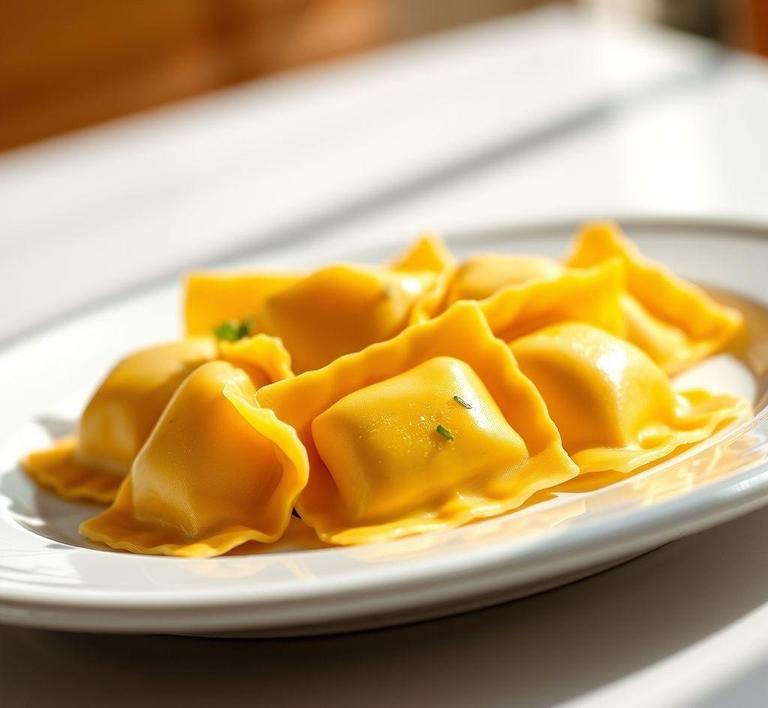If you’ve ever cooked a big batch of cheese ravioli and found yourself with leftovers, you might be wondering whether it’s okay to refreeze them for later. The answer isn’t as simple as yes or no-it depends on a few factors like how the ravioli was stored, when it was frozen, and how it was previously thawed. In this guide, we’ll break down everything you need to know about refreezing cheese ravioli, from the best methods to keep them tasting fresh to potential pitfalls you’ll want to avoid. By the end, you’ll have all the info you need to confidently store and enjoy your ravioli another time!
Can You Refreeze Cheese Ravioli?

The short answer is: yes, you can refreeze cheese ravioli, but with caveats.
Cheese ravioli is a beloved staple in many kitchens – soft pasta pillows cradling rich, creamy cheese fillings, often ricotta-based, sometimes accented with Parmesan or mozzarella. When frozen, it preserves remarkably well due to its low moisture content and compact form. However, refreezing any previously thawed food requires careful consideration of both food safety and quality.
Refreezing cheese ravioli is safe as long as the ravioli was thawed properly – that is, in the refrigerator and not left out at room temperature for more than two hours. When thawed this way, harmful bacteria have a far lower chance of multiplying. If the ravioli was cooked and cooled quickly, it can also be safely refrozen. But with every freeze-thaw cycle, there are trade-offs in texture and taste.
How To Refreeze Cheese Ravioli?
Whether the ravioli is raw or cooked, the refreezing process should be done with precision to mitigate potential quality degradation. Here’s a step-by-step guide:
-
Assess Freshness and Safety:
First, ensure the ravioli was not left out for too long. As a general food safety rule, discard any ravioli that has been sitting at room temperature for over two hours. If it was thawed in the fridge and has no off smells or discoloration, you’re good to go.
-
Dry Off Moisture:
Excess moisture is your enemy when it comes to freezing pasta. If the ravioli has been thawed or cooked and you plan to refreeze it, pat it dry gently with a paper towel. Moisture contributes to ice crystal formation, which damages the pasta structure.
-
Flash Freeze (Optional, but Recommended):
To prevent the ravioli pieces from sticking together in a massive frozen clump, place them on a parchment-lined baking sheet in a single layer and freeze for about 1-2 hours. This ‘flash freezing’ helps them stay individually frozen.
-
Package Properly:
Once the ravioli are firm, transfer them into airtight containers or heavy-duty freezer bags. Press out as much air as possible to avoid freezer burn. If you’re using bags, a vacuum sealer can be especially helpful for maintaining freshness.
-
Label and Date:
Always mark your container with the date of refreezing. Try to use the ravioli within 1-2 months to retain optimal texture and flavor.
Quality Impact
Here’s where it gets nuanced.
Pasta, by its very nature, is not immune to textural changes during freezing. Cheese ravioli is doubly delicate – the outer pasta shell can become mushy or gummy, while the cheese filling may lose its creamy smoothness and become grainy. This is primarily due to ice crystal formation, which disrupts the integrity of the ingredients.
Each freeze-thaw cycle exacerbates this. For uncooked ravioli, the pasta becomes more susceptible to splitting when boiled after refreezing. For cooked ravioli, the structural compromise is often more noticeable – a once springy bite turns soft and less appetizing.
Flavor-wise, dairy-rich fillings like ricotta can suffer a slight degradation. You may notice a dulling of the bright, fresh flavor that makes cheese ravioli so comforting. Herbs and spices might lose their punch, and any subtlety in the cheese blend could be muted.
Still, if refrozen properly and not stored for excessive periods, the quality drop is often minor enough that the ravioli remains quite enjoyable, especially when served with a robust sauce like marinara, pesto, or brown butter and sage.
Refreezing cheese ravioli is entirely possible – and, in many busy kitchens, a practical necessity. The key lies in safe thawing, careful handling, and smart freezing techniques. While some loss of texture and flavor is almost inevitable, these can be minimized with flash freezing, proper packaging, and timely consumption.
Ultimately, whether you’re meal-prepping for the week or salvaging leftovers from a dinner gone uneaten, knowing how to refreeze cheese ravioli gives you flexibility without compromising too much on quality. Just remember: the fewer the freeze-thaw cycles, the better your cheesy pasta pockets will taste.
Is It Safe To Refreeze Cheese Ravioli?
Refreezing cheese ravioli is not inherently dangerous, but it depends heavily on how the ravioli was handled after its initial thawing. The safety and quality of refreezing this beloved Italian staple hinges on time, temperature, and exposure.
If the cheese ravioli was thawed in the refrigerator and has been kept at or below 40°F (4°C) the entire time, then yes – it can be safely refrozen. This is because cold temperatures inhibit the growth of harmful bacteria that can multiply quickly in warmer conditions. Refreezing under these circumstances may slightly alter the texture – softening the pasta or drying out the cheese – but it won’t pose a health hazard.
However, if the ravioli was left to thaw at room temperature for more than two hours, or exposed to warm temperatures (e.g., thawed in hot water or a microwave and then left sitting), refreezing becomes risky. In such conditions, bacteria like Listeria monocytogenes or Salmonella may begin to multiply rapidly, making the food unsafe even after re-freezing.
Signs That Cheese Ravioli Should Not Be Refrozen
To ensure food safety, it’s crucial to be able to spot when cheese ravioli is no longer fit for refreezing. Here are the red flags to watch for:
- Off or Sour Odor: A pungent or acidic smell emanating from the ravioli is often a sign that the dairy in the filling has begun to spoil. Spoiled cheese develops a distinct, unpleasant aroma that should never be ignored.
- Slimy Texture: While pasta can become soft or sticky after freezing, a slimy or gooey surface – especially on the cheese filling – indicates bacterial activity. If the ravioli feels unusually slick or tacky, it’s best to discard it.
- Discoloration: Cheese ravioli should maintain a consistent creamy color. If you notice gray patches, green specks (potential mold), or any significant darkening, the product has likely begun to decompose.
- Time Spent at Room Temperature: If the ravioli sat out for more than two hours (or more than one hour in temperatures above 90°F/32°C), it should not be refrozen or even consumed. At this point, harmful bacteria may have reached dangerous levels, even if the ravioli looks and smells fine.
Common Refreezing Mistakes
Refreezing food, including cheese ravioli, is a delicate process. Many people make missteps that compromise safety and taste. Avoid these common mistakes:
- Thawing on the Counter: One of the most frequent errors is letting ravioli thaw at room temperature. Bacteria thrive in the ‘danger zone’ between 40°F and 140°F. Even short periods in this zone can encourage rapid microbial growth.
- Refreezing After Cooking but Leaving It Out Too Long: Cooked ravioli that’s left out for hours before being returned to the freezer may seem safe – after all, it was cooked – but bacterial spores can survive cooking and multiply once the temperature allows.
- Repeated Freezing and Thawing Cycles: Constantly thawing and refreezing ravioli weakens the structural integrity of the pasta, turns the cheese grainy, and encourages bacteria to proliferate during each thaw cycle. It’s best to portion ravioli before freezing to avoid unnecessary repeated thawing.
- Using Non-Airtight Containers: Air exposure in the freezer leads to freezer burn, which dries out the ravioli and degrades its flavor. If the ravioli wasn’t well-sealed before the first freezing, it will only worsen after a second stint in the freezer.
Tips And Tricks
Maximize both safety and taste when freezing or refreezing cheese ravioli with these practical tips:
- Portion Before Freezing: Divide ravioli into meal-sized portions and store in freezer-safe bags or containers. This avoids the need to thaw a large batch when only a small portion is needed.
- Label and Date Everything: Always write the date on your freezer bags. Refrozen ravioli should be used within 1-2 months to preserve quality, even though it remains safe longer.
- Vacuum Seal or Double Wrap: Minimize exposure to air by using a vacuum sealer. If not available, wrap the ravioli in plastic wrap and then place it in a zip-top freezer bag, squeezing out as much air as possible.
- Thaw Properly: Always thaw cheese ravioli in the refrigerator overnight. If you’re in a rush, cook directly from frozen – particularly if the ravioli is intended for boiling or baking – to bypass unsafe temperatures altogether.
- Don’t Refreeze More Than Once: Ideally, only freeze and thaw cheese ravioli once. Each cycle introduces subtle changes in texture and flavor and increases the risk of spoilage if mishandled.
Conclusion
Refreezing cheese ravioli isn’t off-limits – but it’s a practice that demands attention to detail and a commitment to food safety. The key is ensuring that the ravioli was stored under safe conditions throughout its lifecycle. If you thawed it properly in the fridge, kept it cold, and haven’t allowed it to linger at room temperature, you can safely refreeze it. But if there’s any doubt – an odd smell, unusual texture, or time spent out on the counter – it’s better to be cautious and discard it.
Ultimately, with a bit of foresight and careful handling, you can extend the life of your cheese ravioli without compromising taste or health. Whether you’re meal-prepping or simply trying to avoid food waste, knowing how to freeze and refreeze correctly is a small kitchen skill with big benefits.


